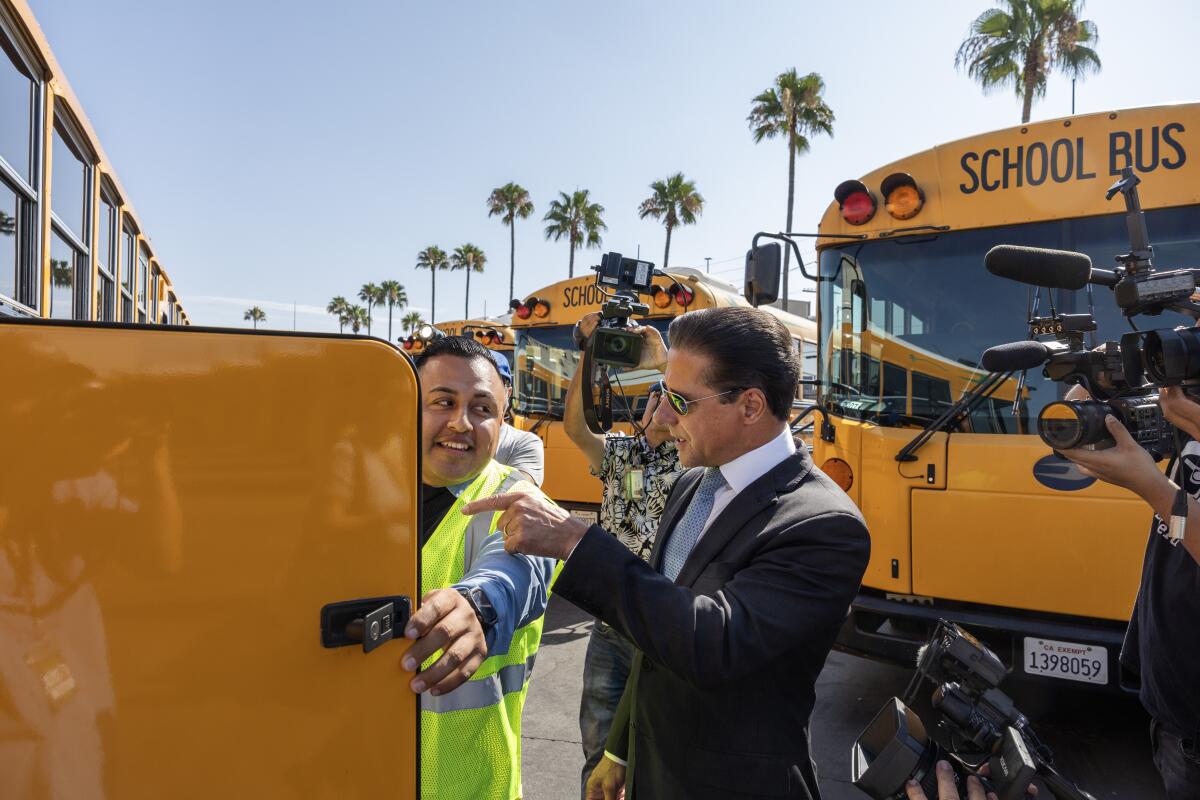LAUSD poised to put $9-billion bond measure, its largest, before voters in November

Los Angeles school officials on Wednesday will decide whether to put a $9-billion school construction bond on the ballot in November — the largest in district history and comparable in size to the $10-billion statewide school bond measure that is already going before voters.
A two-thirds majority — or at least five of seven board members — must vote yes and board approval is widely expected. In November, at least 55% of those casting ballots must vote yes for passage. In 2008 and 2020, voters approved $7-billion L.A. district bonds.
If approved by voters, the bond would raise property taxes for the median-priced home about $273 a year, according to estimates by the Howard Jarvis Taxpayers Assn. A district spokesperson put the median impact at closer to $100, saying the fee would be based on a home’s assessed value not the market value.
L.A. school officials said in a staff report that the needs “are great — more than 60% of school buildings are over 50 years old and desperately in need of upgrades, which means most of Los Angeles Unified students are attending school in deteriorating and aging facilities that do not meet today’s standards for learning and safety.”
“Despite the upgrades that have already been completed or are underway, current estimates show that collectively Los Angeles Unified schools have over $80 billion of unfunded school facility and technology needs, and those needs grow every year,” according to the report.
School bond supports say the money is direly needed to help fund repairs and upgrades at thousands of California public elementary, middle and high schools and community colleges.
The meeting was scheduled with 24 hours advance notice — the legal minimum. The board faced a Friday deadline to get the bond issue on the November ballot.
How would the bond money be used?
A summary of the initiative, posted Tuesday, spoke of the need “to upgrade, modernize, and replace aging and deteriorating school facilities, including school technology infrastructure and equipment.”
Goals also include “enhancing and expanding outdoor spaces and food services for students” and promoting “energy efficiency.”
From the mid-1980s through the early 2000s, the school system coped with crowding by operating year-round — but with a calendar that reduced the number of school days for students by nearly a month. And scheduling limitations excluded many students from advanced coursework. Meanwhile, playgrounds became seas of asphalt broken up by portable classroom buildings.
In response, the school system has passed a series of bonds since the late 1990s.
High construction costs reduced the original scope of the project, but the effort returned students to a full school year and to their neighborhood schools. This was possible in part because enrollment began to decline steadily, a trend that has continued.
New challenges in 2024
The current challenge is to repair aging campuses and modernize and improve classrooms and school buildings.
The existing construction program is not yet out of money — it still has several billion dollars to spend — but these funds already are committed to planned, high-priority projects. Unfunded high-priority projects would be far more than enough to exhaust the $9 billion being sought, officials said.
An example of the current wave of projects is the ongoing reconstruction of Belvedere Middle School in East Los Angeles and Roosevelt High School in Boyle Heights.
It also could be seen Monday at Jordan High School in Watts. Bond money had been used to build a wellness clinic that will serve the physical and mental health needs of families in a low-income community that is short on healthcare.
This clinic first opened in 2008, but the provider could not keep it going during the COVID-19 pandemic. A new provider, UMMA Community Clinic, is taking over the refurbished facility.
“What we have behind us is proof positive that what is happening in this community is still not a reality [in] many other communities,” said L.A. schools Supt. Alberto Carvalho. “So continued investments in physical infrastructure like these wellness centers, like air conditioning units, like roofs, window replacement. All the things that we want to see in every single community continue to be a priority for our district and our school board.”
The district also could use bond funds to pay for projects such as the continued conversion from a gas-powered to an electric fleet of school buses.
What about the state school bond?
Proposition 2 would allow the state to borrow $10 billion to help fund repairs and upgrades at thousands of public elementary, middle and high schools and community colleges across California.
The money from the last successful school bond, which passed in 2016, has long since been spent, and the state’s school repair fund is expected to be depleted by January. There is a wait list of districts hoping the new bond will pass so that $3.4 billion can be provided for already approved projects to take care of hazardous mold, leaky roofs and septic systems, as well as to build classrooms, modernize science labs and replace aging buildings.
Proposition 2 would provide $8.5 billion in facility renovations and new construction for TK-12 schools, with 10% of the funds dedicated to small school districts. Community colleges would receive $1.5 billion. If approved by a simple majority of voters, the bond would allow legislators to borrow money that would be repaid out of the state budget over time.
Opposition emerges
A spokesperson for the Howard Jarvis Taxpayers Assn. voiced opposition to the Los Angeles school district bond.
“At a time when Los Angeles homeowners are struggling to pay the high cost of living, including skyrocketing utility bills, this bond would sharply increase property taxes,” said Susan Shelley, the group’s vice president for communications.
Using the district’s description of the measure’s impact, she calculated that over 30 years, the owner of a median-priced home “would pay over $8,200 in increased property taxes for this bond alone.”
She added: “With enrollment declining, taxpayers have a right to ask that all possible cost savings be implemented before the district asks for another tax increase.”
The Jarvis association also opposes the state school bond.
School-board seats also will be on the ballot in November. Three of the seven seats — which are divided geographically — will be up for grabs.
More to Read
Sign up for Essential California
The most important California stories and recommendations in your inbox every morning.
You may occasionally receive promotional content from the Los Angeles Times.












